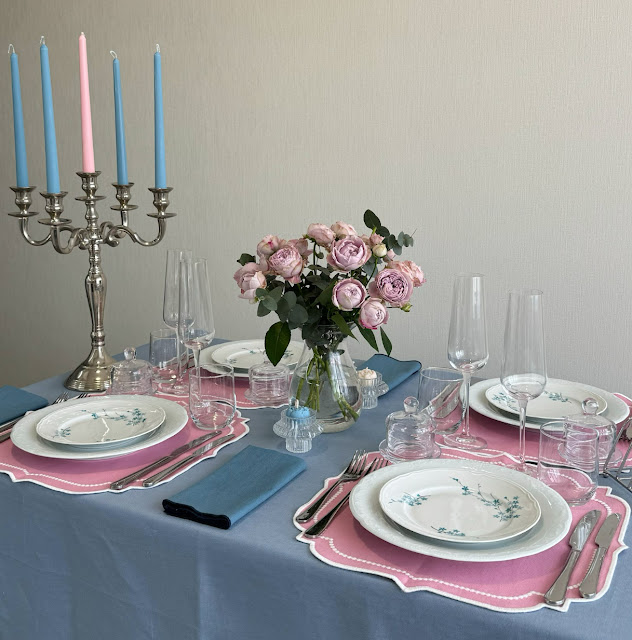 |
| “Delicacy of manner at table stamps both man and woman, for one can, at a glance, discern whether a person has been trained to eat well and to hold the knife and fork properly, to eat without the slightest sound of the lips, to drink quietly, to use the napkin rightly, to make no noise with any of the implements of the table, and last, but not least, to eat slowly and masticate the food thoroughly.” From the White House Cook Book – Above, stereographic card of the White House tables, elaborately set and ready for a dinner in honor of Prince Henry, in 1903 |
White House Cookbook has a style all its own
One day when I was a little girl, my great grandmother let me look through some of her things. In a stack of her cookbooks, of which there were many, I came across one called “The White House Cookbook” with no author's name. Actually, the book undoubtedly had an author, but it was so old even then some of the pages were missing off the front. Nevertheless, to me this cookbook seemed like one of the greatest treasures a person could have recipes that were really used by the Presidents of the United States. When my grandmother and I were going through my great grandmother’s things after she passed away I found the cookbook again and asked if I could have it. Needless to say, she agreed.
Since then, other cookbooks have come out with collections of Presidential recipes, but none are written in the style of this one. I cannot attest to the President who was in office when it was written, because the copyright date is on one of the missing pages, but I know for sure it was a long time ago.
To celebrate the birthdays of presidents George Washington and Abraham Lincoln, which are coming up next month, I thought it would be fun to share some of the passages of this book with you. Although I find many things about it to be funny today, it is still a special “treasure.”
To prepare one for a Presidential dinner, I suppose, “Small Points on Table Etiquette” is the heading of one of the sections.
It begins, “Delicacy of manner at table stamps both man and woman, for one can, at a glance, discern whether a person has been trained to eat well and to hold the knife and fork properly, to eat without the slightest sound of the lips, to drink quietly, to use the napkin rightly, to make no noise with any of the implements of the table, and last, but not least, to eat slowly and masticate the food thoroughly.”
It goes on to warn, “Be careful to keep the mouth shut closely while masticating the food. It is the opening of the lips which causes the smacking which seems so disgust- ing. Chew your food well, but do it silently, and be careful to take small mouthfuls.”
“Another generally neglected obligation,” it continues, "is that of spreading butter on one's bread as it lies in one's plate, or but slightly lifted at one end of the plate. It is very frequently buttered in the air, bitten in gouges, and still held in the face and eyes of the table with the marks of the teeth on it.
“This is certainly not altogether pleasant, and it is better to cut it, a bit at a time, after buttering it, and put piece by piece in the mouth with one's finger and thumb.”
“Don't when you drink.” it admonishes, “elevate your glass as if you were going to stand it inverted on your nose. Bring the glass perpendicularly to the lips, and then lift it to a slight angle. Do this easily.”
And finally, “One’s teeth are not to be picked at table; but if it is impossible to hinder it, it should be done behind the napkin.”
Why the author found it necessary to give instructions like these to those who might be attending a presidential dinner is a wonder, but it could be a clue to the time it was written. Our forefathers were many terrific things, but they were also rough-hewn pioneers, who were undoubtedly lacking in social graces.
The next section, “Management and Directions of Dinners and Receptions on State Occasions at the White House,” includes a table-seating chart, and instructions written with errors in syntax which would have been “X'd” out by any editor of today. The directions themselves, in fact, lead to humorous speculation.
It begins, “Etiquette as observed in European courts is not known at the White House... The President’s seat is in the middle of the table.” (That must have been a sight.) “The most distinguished guests sit on his right and left. If their wives are present they will occupy these seats, and the gentlemen will be seated next to the President’s wife whose seat is directly opposite the President.” (Considering where the President was sitting, this would have been quite a sight too.)
“Corsage bouquets for ladies consist of not more than 8 large roses tied together by silk ribbon,” (I wonder how many women were trying to wear more than eight?) “with the name of the lady stamped on in gold letters.”
“Gentlemen's boutonnieres consist only of one rosebud.” (Only one. The poor things.)
And, “Liquors, cordials, and cigars are served on a separate table after the ladies have retired to the parlor.”
Times have definitely changed, haven't they? But, why the author felt it necessary to let the reader in on the fact that etiquette found in European courts was not known at the White House, and then clue him in, in the same book, that picking his teeth at the table was not “de rigueur” beats me.
It seems to me that if the reader knew what was going on in European courts he'd also know what to do at table. But then, what do I know?
Mrs. Cleveland's wedding lunch, the books says, was held June 4, 1888 and the menu consisted of “consommé en tasse (a cup of consommé), soft-shell crabs, Coquilles de Ris de Vean, (rice in sea shells) snipes (a wading bird) on toast, lettuce and tomato salad, fancy ice cream, cakes, tea, coffee, fruits and mottos.”
Now, I really don't know what else “mottos” would be but little sayings to live by, a serving custom which, if popular then, has definitely fallen into disuse at luncheons I've attended recently as have snipes, come to think about it tut, tut, what a pity.
The wines served are still quite “the thing” however Chateau d’Iquem is possibly the most expensive dessert wine available today, at $175 a bottle. And, Moet and Chandon champagne is still very popular.
Unfortunately, the book does not list a menu for Lincoln’s Birthday, I don't know why. But here is one for Washington’s Birthday oysters on the half shell, mock turtle soup, baked white fish with béchamel sauce, boiled turkey with oyster sauce, boiled sweet potatoes, stewed tomatoes, scalloped onions, salmi of game (a highly seasoned dish of game partly roasted then stewed in wine), olives, Bavarian Cream, Washington Pie, marble cake, variegated jelly (a three- layered molded gelatin), candied fruits, raisins, nuts and coffee.
The coffee recipe is kind of different.
COFFEE
“One full coffee cup full of ground coffee, stirred with one egg and part of the shell, adding a half cupful of cold water. Put it into the coffee boiler, and pour on to it a quart of boiling water. As it rises and begins to boil, stir it down with a silver spoon or fork. Boil hard for 10 or 12 minutes. Remove from the fire and pour out a cupful of coffee, then pour back into the coffee pot. Place it on the back of the stove or range where it will keep hot (and not boil); it will settle in about 5 minutes. Send to the table hot. Serve with good cream and lump sugar. Three-quarters of a pound of Java and 4 pound of Mocha make the best mixture of coffee.”
And here is the recipe for Washington Pie:
WASHINGTON PIE (Like a Boston Cream Pie)
“Cream Part Put on a pint of milk to boil. Break 2 eggs into a dish and add 1 cup of sugar and a cup of flour previously mixed. After beating well, stir it into the milk just as the milk commences to boil; add 1½ ounces butter and keep on stirring one way until it thickens. Flavor with vanilla or lemon.
“Crust Part (a cake) 3 eggs beaten separately, 1 cup of granu- lated sugar, 1½ cups of sifted flour, 1 large teaspoonful of baking powder and 2 tablespoonfuls of milk or water. Divide the batter in half and bake in 2 medium-sized pie tins. Bake in a rather quick oven to a straw color. When done and cool, split each one in half with a sharp broad-bladed knife, and spread half the cream between each.
Serve cold. The cake part should be flavored the same as the custard." As you can see this recipe leaves a bit to the imagination. But, try it if you like. They also suggest serving the pie very cold with a dish of strawberries or raspberries. – By Patty Brown, Desert Sun Food Editor, 1985
🍽Etiquette Enthusiast, Maura J. Graber, is the Site Editor for the Etiquipedia© Etiquette Encyclopedia























